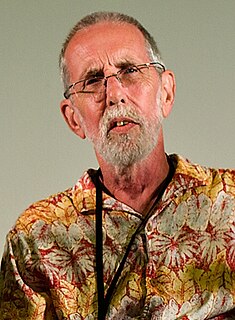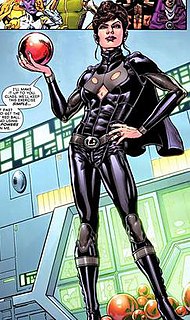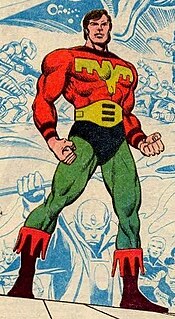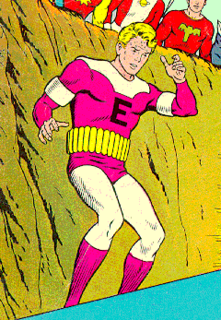Related Research Articles

The Legion of Super-Heroes is a fictional superhero team appearing in American comic books published by DC Comics. Created by writer Otto Binder and artist Al Plastino, the Legion is a group of superpowered beings living in the 30th and 31st centuries of the DC Comics Universe, and first appears in Adventure Comics #247.

Lar Gand, known mainly as Mon-El, is a fictional character appearing in American comic books published by DC Comics, commonly in association with the Legion of Super-Heroes, Superboy, and Superman. The character has been reinterpreted over the years, but in all versions, he serves as a hero with abilities similar to those of Superman, sometimes serving as a substitute for him.

Keith Ian Giffen is an American comics artist and writer. He is known for his work for DC Comics on their Legion of Super-Heroes and Justice League titles as well as for being the co-creator of Lobo.

Paul Levitz is an American comic book writer, editor and executive. The president of DC Comics from 2002–2009, he has worked for the company for over 35 years in a wide variety of roles. Along with publisher Jenette Kahn and managing editor Dick Giordano, Levitz was responsible for hiring such writers as Marv Wolfman and Alan Moore, artists such as George Pérez, Keith Giffen, and John Byrne, and editor Karen Berger, who contributed to the 1980s revitalization of the company's line of comic book heroes.

Night Girl is a fictional character in the 30th century of the DC Universe. She is a member of the Legion of Substitute Heroes, and of the most recent incarnation of the Legion of Super-Heroes. She first appeared in Adventure Comics #306.

The White Witch is a fictional comic book character who exists in the DC Universe, a member of the Legion of Super-Heroes in the 30th and 31st centuries. Her real name is Mysa Nal, although her name was given as Xola Aq in Silver Age Legion stories in Adventure Comics; the revelation that her name was actually Mysa Nal was a later retcon. She is the sister of fellow Legionnaire Dream Girl and daughter of former High Seer of Naltor Kiwa Nal. Like Dream Girl, she is a native of the planet Naltor, where nearly everyone has the power of precognition; however, unlike most Naltorians, Mysa cannot foresee the future.

Ultra Boy is a fictional character, a comic book superhero in DC Comics. He is a member of the Legion of Super-Heroes in the 30th and 31st centuries of the DC Universe. Ultra Boy gained his powers when the vehicle he was flying through outer space was swallowed by an ultra-energy beast, exposing him to radiation while inside. His real name is derived from the biblical figure Jonah who also survived being swallowed by a "large fish".

Element Lad is a fictional character in the 30th and 31st centuries of the DC Comics Universe, a member of the Legion of Super-Heroes. A native of the planet Trom, he has the power to transmute chemical elements.

Chemical King is the name of two fictional characters in the DC Comics universe. The first was Mr. Lambert, who was murdered under the direction of Alfred Stryker in "The Case of the Chemical Syndicate," the feature story of Detective Comics #27. The second character named Chemical King was a member of the Legion of Super-Heroes in the 30th century.

Laurel Gand is a fictional superheroine in the 30th/31st-century DC Comics universe, and a member of the Legion of Super-Heroes. She was created as a replacement for Supergirl in post-Crisis on Infinite Earths Legion continuity. She was also inspired by elements of Superman's supposed descendant Laurel Kent.
Mordru is a fictional supervillain appearing in books published by DC Comics. Created by writer Jim Shooter and artist Curt Swan, Mordru first appeared in Adventure Comics #369.
The Dark Circle is a fictional criminal organization in that appears in comic books from DC Comics, primarily part of the Legion of Super-Heroes comic books. They first appeared in 1968, created by Jim Shooter as a criminal organization founded by five members and populated by a multitude of clones of the original five members.

"The Great Darkness Saga" is a five-issue American comic book story arc featuring the Legion of Super-Heroes. It was written by Paul Levitz, with art by Keith Giffen and Larry Mahlstedt. Published by DC Comics in 1982, the arc first appears in Legion of Super-Heroes vol. 2, #290–294. It is notable for featuring appearances by virtually every living past and present Legionnaire as of 1982, as well as most of the team's 30th-century allies, including the Legion of Substitute Heroes, the Wanderers, the Heroes of Lallor, and the 20th-century Kryptonian refugee Dev-Em. The heroes battle an immensely powerful being shrouded in darkness, ultimately revealed to be the ancient ruler of Apokolips, Darkseid.
Tom and Mary Bierbaum are an American husband-and-wife writing team, known for their work on the DC comic book Legion of Super-Heroes.

The 1958 version of the Legion of Super-Heroes is a fictional superhero team in the 31st century of the DC Comics Universe. The team is the first incarnation of the Legion of Super-Heroes, and was followed by the 1994 and 2004 rebooted versions. It first appeared in Adventure Comics #247 and was created by Otto Binder and Al Plastino.
"The Greatest Hero of Them All" is a story arc that was published by DC Comics, and presented in Superman vol. 2, #8, Action Comics #591, and Legion of Super-Heroes vol. 3, #37–38 from August through September 1987. It was written by Paul Levitz and John Byrne, and pencilled by Byrne, Greg LaRocque and Mike DeCarlo. The story arc was DC’s first attempt to correct the inconsistencies in Legion history created when the original Superboy was removed from mainstream DC continuity in the Man of Steel limited series.

Richard Kent Shakespeare, occasionally codenamed Impulse, is a fictional character in the DC Universe. He became a member of the Legion of Super-Heroes in the 30th century, during the "Five Years Later" era. Prior to New 52 continuity, he was the Superman of the 31st century.

Devlin O'Ryan, occasionally codenamed Reflex, is a fictional character in the DC Universe. He became a member of the Legion of Super-Heroes in the 30th century, during the "Five Years Later" era. Creator Tom Bierbaum said this about Devlin's origin: " My original sketch when I conceived of Devlin had him with a similar emblem with three stars in a row across the middle of the circle and the early depictions of Devlin had the three stars, but it later was simplified to a single star, probably by Keith, maybe when he was doing quick thumbnail layouts for Jason Pearson."
"End of an Era" is an American comic book story arc that was published by DC Comics, and presented in Legion of Super-Heroes vol. 4, #60-61, Legionnaires #17-18, and Valor #22-23. It was written by Mark Waid, Tom McCraw and Kurt Busiek, with pencils by Stuart Immonen, Ron Boyd, Chris Gardner and Colleen Doran. A tie-in to the Zero Hour: Crisis in Time miniseries, it is the final story arc in the Legion of Super-Heroes' original timeline, and marks the end of 36 years of unbroken Legion continuity.
"The Terra Mosaic" is a story arc that was published by DC Comics, and presented in Legion of Super-Heroes vol. 4, #25-36. It was written by Keith Giffen and Tom and Mary Bierbaum, and was pencilled primarily by Jason Pearson. The story arc takes place during the "Five Years Later" period of the Legion of Super-Heroes' original continuity. It features the introduction of "Batch SW6" — time-displaced duplicates of the regular, adult version of the Legion — who become key participants in a war to free Earth from the control of the Dominators.
References
- ↑ Siegel, Jerry (w), Forte, John (p), Forte, John (i), Snappin, Milton (let), Wiesinger, Mort (ed). "The Menace of the Sinister Super-Babies!" Adventure Comics 338(November 1965), New York City : DC Comics
- ↑ Byrne, John (w), Byrne, John (p), Byrne, John (i), Ziuko, Tom (col), Costanza, John (let), Giordano, Dick (ed). "Past Imperfect" Action Comics 591(August 1987), New York City : DC Comics
- ↑ Levitz, Paul (w), LeRoque, Greg (p), DeCarlo, Mike (i), Gafford, Carl (col), Costanza, John (let), Giordano, Dick (ed). "The Greatest Hero Of Them All" Legion of Super-Heroes v3, 38(September 1987), New York City : DC Comics
- ↑ Giffen, Keith , Bierbaum, Tom ; Bierbaum, Mary ; Gordon, Al (w), Giffen, Keith (p), Gordon, Al (i), McGraw, Tom (col), Klein, Todd (let), Giordano, Dick (ed). "Legion of Super-Heroes" Legion of Super-Heroes v4, 5(March 1990), New York City : DC Comics
- ↑ Giffen, Keith , Bierbaum, Tom ; Bierbaum, Mary ; Gordon, Al (w), Giffen, Keith (p), Gordon, Al (i), McGraw, Tom (col), Klein, Todd (let), Giordano, Dick (ed). "Legion of Super-Heroes" Legion of Super-Heroes v4, 6(April 1990), New York City : DC Comics
- ↑ Starlin, Jim , Levitz, Paul (w), Starlin, Jim (p), Rubinstein, Jim (i), Adams, Cory (col), Oda, Ben (let), Milgrom, Al (ed). "Murder Most Foul" Superboy and the Legion of Super-Heroes 239(May 1978), New York City : DC Comics
- 1 2 3 Birnbaum, Tom and Mary (w), Braithwaite, Doug (p), Hazlewood, Doug , Mahlstedt, Larry (i), McCraw, Tom (col), Klein, Todd (let), Eury, Mike (ed). "Charade" Legion of Super-Heroes v4, 1(1990), New York City : DC Comics
- ↑ Giffen, Keith , Bierbaum, Tom ; Bierbaum, Mary ; Gordon, Al (w), Giffen, Keith (p), Gordon, Al (i), McGraw, Tom (col), Klein, Todd (let), Giordano, Dick (ed). "Five Years Later" Legion of Super-Heroes v4, 1(November 1989), New York City : DC Comics
- 1 2 3 Giffen, Keith , Grant, Alan (w), Kitson, Barry (p), McKenna, Mark (i), Whitmore, Glen (col), Saladino, Gaspar (let), Giordano, Dick (ed). "Second Chances" L.E.G.I.O.N. '89 9(November 1989), New York City : DC Comics
- 1 2 Grant, Alan (w), Fern, Jim , Piers Rayner, Richard (p), DeMulder, Kim (i), Kindzierski, Lovern (col), Saladino, Gaspar (let), Giordano, Dick (ed). "I, Durian" L.E.G.I.O.N. '91 23(January 1991), New York City : DC Comics
- ↑ Bridwell, E. Nelson , Kupperberg, Paul (w), Janes, Jim (p), Chiaramonte, Frank (i), D'Angelo, Gene (col), Oda, Ben (let), Harris, Jack C. (ed). "Revelation!" Secrets of the Legion of Super-Heroes 3(March 1981), New York City : DC Comics
- ↑ Bierbaum, Tom and Mary (w), Peterson, Brandon (p), Hanna, Scott (i), McCraw, Tom (col), Chiang, Janice (let), Giordano, Dick (ed). "The Legend of Valor" Legion of Super-Heroes v4, 2(1991), New York City : DC Comics
- ↑ Johns, Geoff (w), Pérez, George (p), Koblish, Scott (i), Hi-Fi Design (col), Napolitano, Nick J. (let), DiDio, Dan (ed). "Book Two" Final Crisis: Legion of 3 Worlds 2(November 2008), New York City : DC Comics
- ↑ Levitz, Paul (w), Jiminez, Phil (p), Lanning, Andy (i), Hi-Fi Design (col), Cipriano, Sal (let), Berganza, Eddie (ed). "First Night" Adventure Comics 523(April 2011), New York City : DC Comics